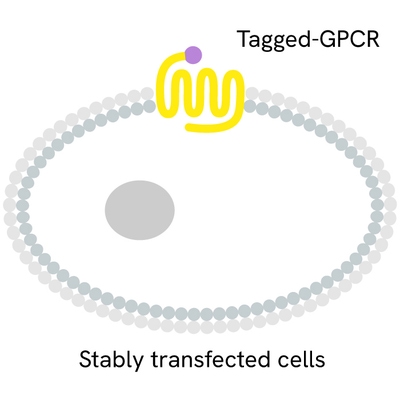

Tag-lite CXCR4 Receptor Stable Cell Line (HEK293)








| Feature | Specification |
|---|---|
| Application | Receptor-Ligand Binding |









Loading...
Product information
Overview
CXCR4 is a receptor for the C-X-C chemokine CXCL12/SDF-1. Compelling evidences suggests that CXCR4 is involved in hematopoiesis and in cardiac ventricular septum formation. The receptor also plays an essential role in vascularization of the gastrointestinal tract. CXCR4 acts as a coreceptor for human immunodeficiency virus-1/HIV-1.
This HEK293 stable cell line expresses the CXCR4 receptor fused to a SNAP-Tag. Labeled with Terbium, the cells can be used in a Tag-lite receptor binding protocol.
How it works
Step 1 - Receptor labeling
SNAP-tag® is a small fusion tag that covalently interacts with specific substrates. It enables specific covalent labeling of any protein of interest. For more details, see the labeling procedure.

Step 2 - Understand the assay principle
Running a receptor binding assay using Tag-lite is as easy as it can get. Simply dispense 10 µL of labeled cells into each well, followed by 5 µL of labeled ligand and 5 µL of the compound you wish to test. Like all HTRF assays, Tag-lite assays do not require any washing steps. A diagram of the procedure to be followed is given on the right.

Step 3 - Saturation binding (KD)
A saturation binding assay measures total and non-specific binding for increasing concentrations of ligand under equilibrium conditions. To perform the assay, the fluorescent ligand is titrated into a solution containing a fixed amount of labeled cells, and then incubated to equilibrium. The HTRF ratio obtained from this titration is the total binding.


Step 4 - Competitive binding (KI)
A competitive binding assay is performed to measure the dissociation constant, Ki. To perform the assay, the compound is titrated into a solution containing a fixed concentration of fluorescent ligand and a fixed amount of cells.


Assay validation
Examples of data obtained using chemokine CXCR4-R expressing stable cells (HEK) labelled with terbium in Tag-lite buffer (LABMED), and their matching fluorescent ligand (L0012RED). AMD-3100 was used as reference ligand. Results may vary from one HTRF® compatible reader to another.


Specifications
| Application |
Receptor-Ligand Binding
|
|---|---|
| Brand |
Tag-lite
|
| Detection Modality |
HTRF
|
| Product Group |
Cells
|
| Shipping Conditions |
Shipped in Dry Ice
|
| Target Class |
GPCR
|
| Technology |
TR-FRET
|
| Therapeutic Area |
Cardiovascular
Infectious Diseases
Metabolism/Diabetes
NASH/Fibrosis
Neuroscience
Oncology & Inflammation
Rare Diseases
|
| Unit Size |
1 each
|
Video gallery
Resources
Are you looking for resources, click on the resource type to explore further.
G-protein coupled receptors (GPCRs) are crucial transmembrane proteins involved in cellular signal transduction.
This technical...
This guide provides you an overview of HTRF applications in several therapeutic areas.


How can we help you?
We are here to answer your questions.






























